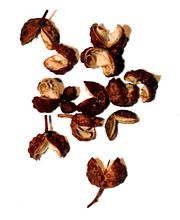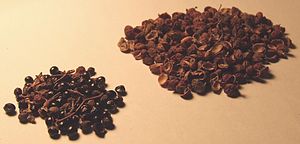
Sichuan pepper
About this schools Wikipedia selection
This Wikipedia selection is available offline from SOS Children for distribution in the developing world. SOS Child sponsorship is cool!
| Sichuan pepper | |||||||
|---|---|---|---|---|---|---|---|
 |
|||||||
| Traditional Chinese | 花 椒 | ||||||
| Simplified Chinese | 花 椒 | ||||||
| Hanyu Pinyin | huājiāo | ||||||
|
|||||||
Sichuan pepper (or Szechuan pepper) is the outer pod of the tiny fruit of a number of species in the genus Zanthoxylum (most commonly Z. piperitum, Z. simulans, Z. sancho and Z. schinifolium), widely grown and consumed in Asia as a spice. Despite the name, it is not related to black pepper or to chili peppers. It is widely used in the cuisine of Sichuan, China, from which it takes its name, as well as Tibetan, Bhutanese, Nepalese, Japanese and Konkani and Batak Toba cuisines, among others.
It is known in Chinese as huājiāo ( 花椒; literally "flower pepper"); a lesser-used name is shānjiāo ( 山 椒; literally "mountain pepper"; not to be confused with Tasmanian mountain pepper). In Japanese, it is 山椒 sanshō, using the same Chinese characters as shanjiao. In Tibetan, it is known as g.yer ma. In Konkani it is known as tepal or tirphal . In Indonesia's North Sumatra province, around Lake Toba, it is known as andaliman in the Batak Toba language and tuba in the Batak Karo language. In America, it is sold as fagara or flower pepper as well as Sichuan pepper.
Culinary uses
Sichuan pepper has a unique aroma and flavour that is not hot or pungent like black or white pepper, or chili peppers, but has slight lemony overtones and creates in the mouth a kind of tingly numbness (caused by its 3% of hydroxy-alpha-sanshool) that sets the stage for these hot spices. Recipes often suggest lightly toasting and then crushing the tiny seedpods before adding them to food. Only the husks are used; the seeds are discarded or ignored. It is generally added at the last moment. Star anise and ginger are often used with it and it figures prominently in spicy Sichuan cuisine. It has an alkaline pH and a numbing effect on the lips when eaten in larger doses. Ma la (Chinese: 麻辣; pinyin: málà; literally "numbing and spicy"), a flavor common in Sichuan cooking, is a combination of Sichuan pepper and chili pepper.
It is also available as an oil (marketed as either "Sichuan pepper oil" or "Hwajiaw oil"). In this form it is best used in stir fry noodle dishes without hot spices. The preferred recipe includes ginger oil and brown sugar to be cooked with a base of noodles and vegetables, with rice vinegar and Sichuan pepper oil to be added after cooking.
Hua jiao yan ( simplified Chinese: 花椒盐; traditional Chinese: 花椒鹽; pinyin: huājiāoyán) is a mixture of salt and Sichuan pepper, roasted and browned in a wok and served as a condiment to accompany chicken, duck and pork dishes. The peppercorns can also be lightly fried in order to make a spicy oil with various uses. In Indonesian Batak cuisine, it is ground into a green sambal Tinombur or chili paste, by mixing with chilis and seasonings to accompany grilled pork, carp and other regional specialities.
Sichuan pepper is one of the few spices important for Tibetan and Bhutanese cookery of the Himalayas, because few spices can be grown there. One Himalayan specialty is the momo, a dumpling stuffed with vegetables, cottage cheese or minced yak meat, beef or pork and flavoured with Sichuan pepper, garlic, ginger and onion. The noodles are steamed and served dry, together with a fiery sauce. Tibetans believe it can sanitize meat that may not be so fresh. In reality it may only serve to mask foul flavours. Perhaps it is because of the foul smell masking property of Sichuan pepper that made it popular in dishes made of visceral organs of slaughtered animals.
In Japan the dried and powdered leaves of Zanthoxylum sancho are used to make noodle dishes and soups mildly hot and fragrant. The whole leaves, 木の芽 kinome, are used to flavour vegetables, especially bamboo shoots, and to decorate soups. Typically the young shoots are used in this way giving and aromatic lemony flavour to food. They are used to denote spring seasonality in food. The buds, seeds, flowers, and hulls are also used.
Sichuan peppercorns are one of the traditional ingredients in the Chinese spice mixture five-spice powder and also shichimi togarashi, a Japanese seven-flavour seasoning.
In Korean cuisine, two species are used: Z. piperitum and Z. schinifolium.
Composition of various species
- Z. fagara (Central & Southern Africa, South America) — alkaloids, coumarins (Phytochemistry, 27, 3933, 1988)
- Z. simulans (Taiwan) — Mostly beta-myrcene, limonene, 1,8-cineole, Z-beta-ocimene (J. Agri. & Food Chem., 44, 1096, 1996)
- Z. armatum (Nepal) — linalool (50%), limonene, methyl cinnamate, cineole
- Z. rhetsa — Sabinene, limonene, pinenes, para-cymene, terpinenes, 4-terpineol, alpha-terpineol. (Zeitschrift f. Lebensmitteluntersuchung und -forschung A, 206, 228, 1998)
- Z. sansho (Japan [leaves]) — citronellal, citronellol, Z-3-hexenal (Bioscience, Biotechnology and Biochemistry, 61, 491, 1997)
- Z. acanthopodium (Indonesia)
The genus name Zanthoxylum or Xanthoxylum comes from the Greek xanthon xylon (ξανθὸν ξύλον), meaning "blond wood."
Other names
It is possible to come across names such as "Szechwan pepper," "Chinese pepper," "Japanese pepper," "aniseed pepper," "Sprice pepper," "Chinese prickly-ash," "Fagara," "sansho," "Nepal pepper," "Indonesian lemon pepper," and others, sometimes referring to specific species within this group, since this plant is not well known enough in the West to have an established name. In Tibet, the spice is known as e-ma or Kham pepper. At least some of the brands found in Asian grocery stores in the United States label the product in a confusing way; for instance, the Oriental Mascot brand labels the spice as "red pepper corn," although the Chinese characters on the package indicate it is Sichuan pepper. Some brands also use the English description "Dehydrated Prickly Ash" since Sichuan pepper, and Japanese sansho, are from related plants that are sometimes called prickly ash because of their thorns.
Sichuan pepper is unrelated to black pepper (genus Piper) and to chile peppers, which are also widely used in Sichuan cookery.
In Nepal, where it is extensively used, it is known as timur ( Z. alatum).
A spice called teppal or tirphal (Zanthoxylum rhetsa) is used in the Indian states of Maharashtra, Karnataka, and Goa, by a very small community called Konkanis (they speak a language called Konkani), an official language of Goa and spoken in many parts of these three states. Teppal is a fruit which grows in bunches like grapes on trees full of thorns. The fresh fruits are parrot green in color and are used as a flavouring agent in many curries made with a paste of coconut, chilis, and other spices. The fruit is seasonal and available during the monsoon period. When dried, the flesh of the fruit hardens, turns a brownish black colour and opens up to show the black seeds within. The seeds are discarded and the dried fruit is stored in containers for use around the year. Mostly used in fish preparations and a few vegetarian dishes, with the coconut masala, this spice has a very strong woody aroma and is discarded at the time of eating the curry. This tree is also called jummn kayee or gamathe haralu in Kannada and koili kaya in Malayalam.


